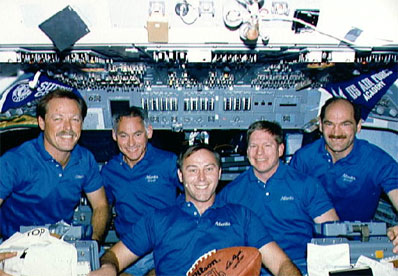After I posted my earlier blog about the Space Shuttle Columbia disaster (STS-107) my former neighbor, astronaut Mike Mullane, contacted me to correct some factual errors I made.
Mike knows from whence he speaks: he’s a veteran of three Space Shuttle missions including his own dangerous encounter with major heat shield tile damage on his classified mission aboard Atlantis in December 1988 (STS-27). I thought readers would appreciate hearing the specifics of what happened directly from him. With Mike’s permission, I’ve included excerpts from his notes below.

Jack – Another great article. Just a couple of comments:
On our STS-27 mission, the damage wasn’t caused by foam falling from the External Tank but rather parts of the tip of the right side booster rocket (SRB). The boosters have an ablative material on their nose cones that provides thermal protection during the heat load seen on ascent as the vehicle goes supersonic in the lower atmosphere. It was some of that ablative material that broke off and damaged our tiles. I’ve attached a photo of our crew examining the damage after landing.

The second photo is looking straight down into the cavity of the missing tile. The missing tile was about 6 inches thick so the cavity is about 6 inches deep. The tiles in this area were very thick because it was a part of the vehicle that saw 2000 plus degrees F on reentry.

On the STS-107 mission (Columbia 2003), the fatal damage was actually on the leading edge of the left wing, not on the silica heat tiles. The leading edges of the wings and the nose of the Orbiters are covered with RCC (reinforced carbon-carbon) which can withstand the 3000 degree F temperature.
I’ve also attached a photo of the test that was done after Columbia’s loss. In the test, an air cannon was used to fire pieces of ET foam at these carbon panels at different speeds/angles. In one test (see photo below), the foam impact resulted in a 16 inch diameter hole. I read that the hole in Columbia’s wing was estimated to be 9 inches in diameter. That provided a pathway for 3000 degree temps to enter an aluminum vehicle that melts at 1000 degrees.
The wing melted off.
Mike

Copyright 2015 Dandelion Beach LLC (Photos courtesy of Mike Mullane)
Images: NASA. Photo of Shuttle Wing Panel Impact Test: KXAS-TV Dallas-NBC, Copyright 2003
 Editor’s Note: Retired Astronaut and Pilot Mike Mullane is the author of Riding Rockets An Astronaut’s Guide to Life on Earth: What Going to Space Taught Me…
Editor’s Note: Retired Astronaut and Pilot Mike Mullane is the author of Riding Rockets An Astronaut’s Guide to Life on Earth: What Going to Space Taught Me…
Copies can be found here











